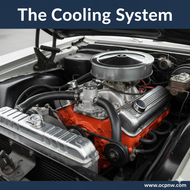When you think about the vital components of your classic car, what comes to mind? The rumbling V8, the perfectly tuned carburetor, or the gleaming chrome trim. But what about the part that quietly works to keep it all from melting down? The water pump.
Often overlooked and taken for granted, the water pump is a mechanical marvel of simplicity and a critical lifeline for any vintage engine. It’s the heart of the cooling system, tirelessly circulating coolant to prevent the kind of catastrophic overheating that can turn a beautiful engine into an expensive paperweight.
A Simple Job, Perfectly Executed
Unlike modern electric pumps, the water pumps in our vintage vehicles are purely mechanical, powered directly by a belt from the engine's crankshaft. As the engine spins, so does the water pump's pulley, which turns an internal impeller.
This impeller is the real hero. Its design creates a pressure differential, drawing hot coolant from the engine block and pushing it through the radiator's core. As the coolant passes through the radiator's fins, it dissipates heat, and the now-cooled fluid is circulated back into the engine to begin the process all over again. This constant, regulated flow is what keeps your engine's temperature in the "Goldilocks Zone" and prevents serious damage.
Why Your Vintage Pump Deserves Your Attention
A vintage water pump, like any mechanical part, is subject to wear and tear. A few key components are prone to failure:
-
The Seals: The internal seals are designed to keep coolant from leaking out. Over time, they can dry out, crack, or wear down, leading to the dreaded coolant leak.
-
The Bearings: The shaft that holds the impeller spins on a set of bearings. Years of stress can cause these bearings to wear out, leading to noise and a wobbly pulley.
A failing water pump won't just leave you stranded on the side of the road—it can cause permanent engine damage. Without proper coolant circulation, temperatures can rise rapidly, leading to a cracked cylinder head, a warped block, or a blown head gasket.
Signs Your Water Pump Is on Its Way Out
Paying attention to these simple warning signs can save you a world of trouble (and a lot of money):
-
Puddle of Coolant: The most obvious sign. If you see green or orange fluid on the ground near the front of your engine, a leaking pump is the most likely culprit.
-
Squealing or Grinding Noise: A worn-out bearing will often make a tell-tale grinding or high-pitched squealing sound from the front of the engine.
-
Overheating: If your temperature gauge starts to creep into the red, especially in stop-and-go traffic, it could be a sign that the pump is no longer circulating coolant efficiently.
-
Wobbling Pulley: With the engine off, try to wiggle the fan belt pulley on the water pump. If it has noticeable side-to-side play, the bearings are shot and the pump needs to be replaced immediately.
Don't let this simple, affordable component be the reason your classic car ends up on a tow truck. A little proactive inspection and maintenance will ensure that this unsung hero of your cooling system continues to do its job, keeping your engine running cool and your driving experience perfect.

